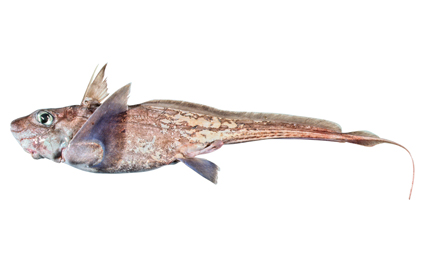Southern Chimaera, Chimaera fulva Didier, Last & White 2008
Other Names: Southern Chimaera

Southern Chimaera, Chimaera fulva. Source: Australian National Fish Collection, CSIRO. License: CC BY Attribution-Noncommercial
Summary:
A silvery-pink to brown ghostshark becoming yellowish-white on the underside of the head, snout, and area surrounding the mouth, with brown fins and a yellowish-white caudal filament. Males have very large trifurcated claspers with bristles on the end.
Cite this page as:
Bray, D.J. & Reardon, M.B. 2025, Chimaera fulva in Fishes of Australia, accessed 01 Jul 2025, https://fishesofaustralia.net.au/home/species/2662
Southern Chimaera, Chimaera fulva Didier, Last & White 2008
More Info
|
Distribution |
Off Broken Bay, New South Wales, around southern Australia, to off Shoal Point, Western Australia, including off Tasmania. |
|
Features |
Snout short, blunt; eye large, diameter about 53–71% snout length; skin easily damaged, lateral line nearly straight past curve just behind head; first dorsal fin slightly taller than spine; posterior end of anal-fin base below about posterior end of second dorsal-fin base; caudal filament about twice head length when complete; pectoral and ventral fins relatively short, pectoral fin just reaching origin of pelvic fin at most, pelvic-fin length more than 1.5 times in distance between pectoral- and pelvic-fin origins. |
|
Size |
|
|
Colour |
Fresh coloration: Pale brownish to silvery pinkish dorsally and laterally, slightly paler ventrally; sides of tail below lateral line canal usually with several faint longitudinal stripes; caudal filament white; first dorsal fin pale brownish, posterior margin paler; second dorsal fin pale brownish basally, dusky on upper half of fin. |
|
Biology |
Males mature at 50.8 cm TL and females mature at 62.8 cm TL. Reproduction is oviparous. |
|
Similar Species |
In the past, the southern chimaera has been confused with the Shortspine Chimaera, Chimaera obscura. The two populations are genetically distinct, and the southern chimaera can be distinguished by its lighter skin colour. |
|
Etymology |
The specific name is from the Latin fulva (= brown), in allusion to the pale brownish body coloration. |
|
Species Citation |
Chimaera fulva Didier, Last & White 2008, CSIRO Marine and Atmospheric Research Paper No. 022: 328, Fig. 1. Type locality: Southeast of Cape Everard, Victoria, Australia, 38°20'S, 149°41'E, depth 991-1009 m. |
|
Author |
Bray, D.J. & Reardon, M.B. 2025 |
|
Resources |
Southern Chimaera, Chimaera fulva Didier, Last & White 2008
References
Didier, D.A., Last, P.R. & White, W.T. 2008. Three new species of the genus Chimaera Linnaeus (Chimaeriformes: Chimaeridae) from Australia. in Last, P.R., White, W.T. & Pogonoski, J.J. (eds). Descriptions of New Australian Chondrichthyans. CSIRO Marine and Atmospheric Research Paper no. 22. http://hdl.handle.net/102.100.100/118353?index=1
Finucci, B., Kemper, J. & Charles, R. 2024. Chimaera fulva. The IUCN Red List of Threatened Species 2024: e.T195429A124541154. https://dx.doi.org/10.2305/IUCN.UK.2024-2.RLTS.T195429A124541154.en. Accessed on 18 June 2025.
Gomon, M.F. 2008. Families Dasyatidae, Myliobatidae, Chimaeridae, Callorhinchidae, Rhinochimaeridae. 138-149 pp. in Gomon, M.F., Bray, D.J. & Kuiter, R.H. (eds). Fishes of Australia's Southern Coast. Sydney : Reed New Holland 928 pp. (as Chimaera sp.)
Kemper, J.M., Ebert, D.A., Naylor, G.J.P. & Didier, D.A. 2014. Chimaera carophila (Chondrichthyes: Chimaeriformes: Chimaeridae), a new species of chimaera from New Zealand. Bulletin of Marine Science 91(1): 63-81 https://doi.org/10.5343/bms.2014.1042
Last, P.R., Scott, E.O.G. & Talbot, F.H. 1983. Fishes of Tasmania. Hobart : Tasmanian Fisheries Development Authority 563 pp. figs. (as Hydrolagus sp.)
Last, P.R. & Stevens, J.D. 1994. Sharks and Rays of Australia. Canberra : CSIRO Australia 513 pp. 84 pls. (as Chimaera sp. A)
Last, P.R. & Stevens, J.D. 2009. Sharks and Rays of Australia. Collingwood : CSIRO Publishing Australia 2, 550 pp.
May, J.L. & Maxwell, J.G.H. 1986. Field Guide to Trawl Fish from Temperate Waters of Australia. Hobart : CSIRO Division of Marine Research 492 pp. (as Chimaera sp. 1)

